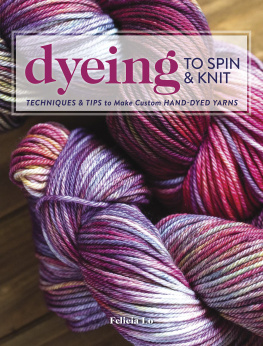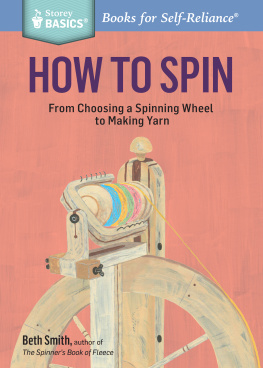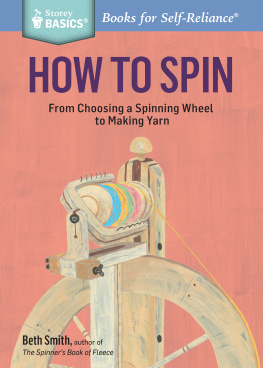Dedication
To my loves, Andy, Isobel, and Henry, for keeping me laughing
Contents
foreword
CLARA PARKES
I still remember my first skein. Lumpy and overtwisted, it was hardly enough yarn to be useful in any way. But it marked the beginning of my journey toward understanding how, with just a little bit of work, you could transform almost any jumble of fibers into yarn.
Like riding a bike, I gradually got better at keeping my spindle (and, soon, wheel) in steady motion while managing an even draft and twist. It seemed absurdly hard at first, but I kept going, and then one day, it clicked.
My fiber consumption slowly increased from a few ounces to a few pounds to a sheeps worth of fleece. Now that I deal in flocks, my currency is the bale. I have someone else do the scouring and spinning and plying and skeining for me. But if I hadnt begun as a handspinner, Id be completely lost. Learning to spin is the very best way to understand how yarn really works and in that regard, I wish every knitter would learn how to do it.
Only after I tried knitting with my handspun did I discover another problem: it turns out spinning yarn is rather easy, but spinning a yarn that serves a purpose, that fulfills your hopes and dreams for a specific knitted project? Thats where the journey toward wisdom really begins and thats where this book begins as well. It assumes you already understand the basics of spinning and are ready to go further.
A masterful explainer of things, Jillian walks you through all the tiny but vital variables that come into play when youre creating a lovely and useful yarn. She touches on choosing your fibers and fiber preparations, working with solid and multicolored fibers, and even juggling the nuances of drafting and plying and finishing. Best of all, Jillian makes it abundantly clear what beautiful rewards await you at the end.
How I wish Jillian had written this book when I was first learning to spin. It wouldve saved me a lot of trial and error... okay, mostly error.
Lucky for you, the book is now here, and its in your hands. Use it well.
foreword
JACEY BOGGS
The human brain is an amazing and confounding instrument, isnt it? When I started spinning, I read everything I could get my hands on that dealt with this craft. I perused and then pored over text after tome after magazine.
Some of it sank in, but much seemed beyond my understanding, presented in a way that didnt fit precisely into my brain. Its one of the reasons I started PLY magazine, because what I wanted wasnt out there yet. My brain style nimble at times, lumbering at others wasnt well represented. I wanted spinning laid out before me like a magnificent feast of hows, whys, and what-ifs. I wanted a clear map from start to finish but one that was smart and open-minded with lots of scenic routes and off-road adventures. I wanted Jillian I just didnt know it yet.
Spinning, with its endless options and differing opinions, can be overwhelming. This is not news to you, I bet. Sometimes it can feel like you have to know everything, to get each thing exactly right, or you might as well give up and go commercial. I felt this many times as I tried to find a way to force all the spinning facts into my strange-shaped brain. Jillians house-building metaphor slides perfectly into my brain, like a key in a lock. It was made for a mind like mine, where the tumblers sometimes jam and require clear and precise instructions or a swift kick. There are a million different ways to build a house, but they all have the same basic elements, and what you choose to spotlight is up to you. Your house might have the brightest front door on the block (look at that colorway), her house might have the sturdiest foundation (great-grandchildren will inherit it), his house sure has nice windows (no cold getting in there); theyre all different and they all bring their inhabitants joy, but you can bet the builder learned from each one.
You are an adventurer, a traveler, a builder. Go explore and build. Learn as you go, pay attention, make alterations, grow and change, and embrace the journey. You dont have to know it all right now. You just have to have a good map, nimble fingers, and an open mind. Youre holding one of the best maps Ive seen, so stretch out your fingers and mind and get started!
Introduction
Why This Book?
Have you noticed how many more spinners there are nowadays? What was once a cozy, tiny group of weirdos has become a loud, brash family. Have you also noticed how many more fibers there are to buy and how many more places to buy it? I never thought I could walk into a knitting store and find beautiful fiber, much less take spinning classes there.
The spinning world is growing, and the spinning world is changing. More spinners are coming from the knitting world. Some come to spinning because they want to create their own yarn, exactly how they want it, choosing every aspect from color to feel to gauge. Some come because they have fallen in love with the braids and batts dyed by one of the hundreds of talented dyers around the world.
Many spinners arent interested in buying a fleece or doing their own preparation they want to spin from the ready-made beauties they buy at the Maryland Sheep and Wool Festival, New York Sheep and Wool Festival (a.k.a. Rhinebeck), Black Sheep Gathering in Oregon, and Madrona Fiber Arts retreat in Washington, as well as from online sites such as Etsy or at their local knitting stores. Its not even just new spinners who fall into that category of spinners I am proudly one of them. Ive been spinning off and on for almost 20 years, and I dont like to process my own fiber. I know how to do it, and I know the upside to choosing and processing, but I am thoroughly in love with handdyed, commercially processed fiber.
Commercially processed fiber has had a bad reputation in the spinning world as overprocessed and compacted, hard to spin and not as worthy as hand-processed fibers. Like the rest of the fiber world, however, commercial processing has grown and matured, developing nuances beyond compacted, scoured fiber. Fibers are being processed in smaller batches, many locally sourced and processed. And the color thats where the magic lies. Thats what draws me across the shop, room, or fairground, keeps me coming back to websites and keeps me spinning. Gone are the days of hobby handdyers who dyed a few braids or batts with Kool-Aid for a local guild sale or fiber fair. The women and men who are dyeing now are artists with full-time businesses. The variety and beauty of their work is astonishing, and my overflowing stash is testament to that.
Many spinners are coming from a knitting background, as I know I did. I spin to use my yarn for knitting. These spinners know about yarn, know what they want in a yarn, and want to know how to make it. They want something unique, something they cant find in a shop. For a long time, the yarn was the end product, the whole point of the activity, and it still is for some spinners. I consider myself a spinning knitter, and my point is to use the yarn, whether Im spinning for a particular project or spinning for the joy of it and then finding a project to use it for.











